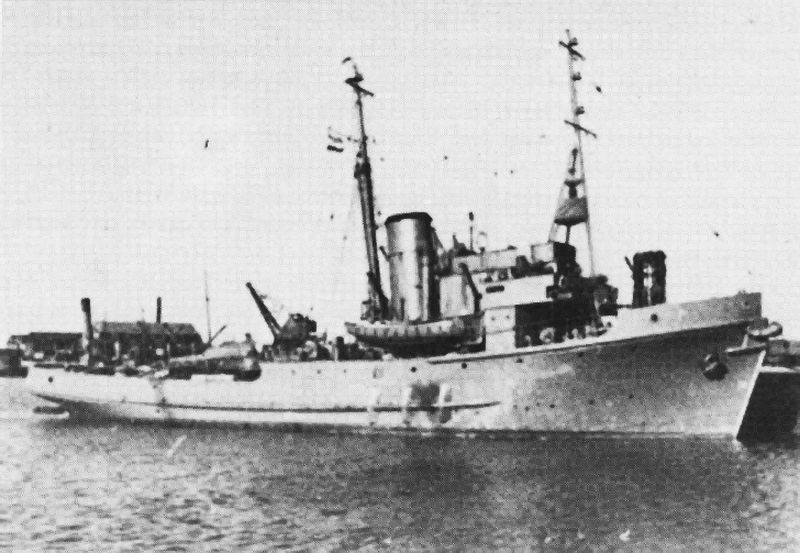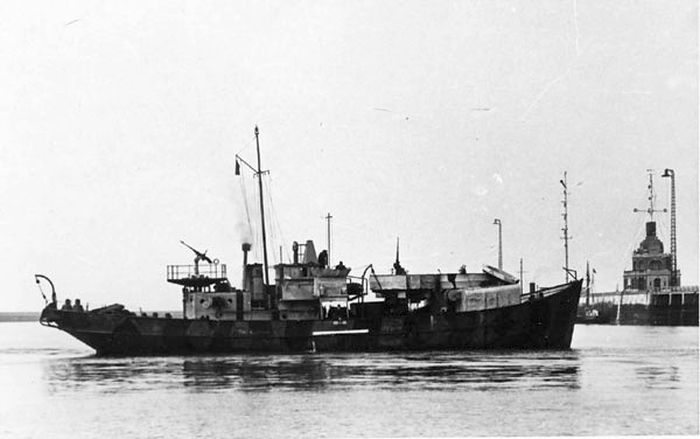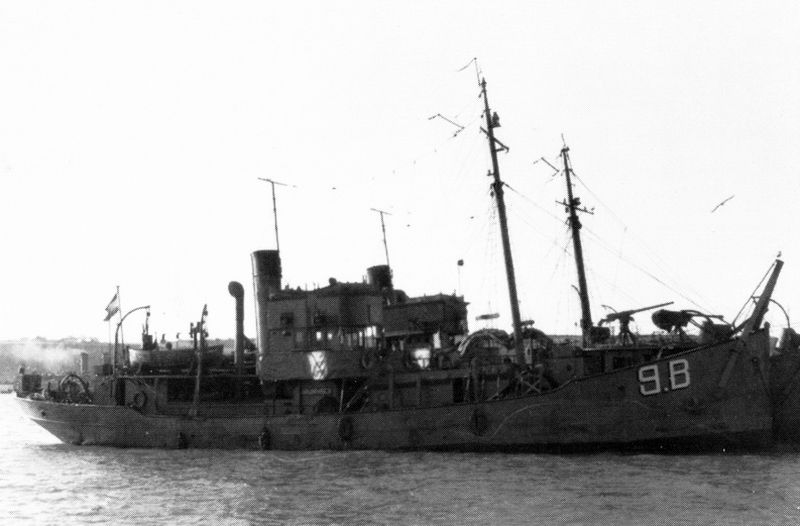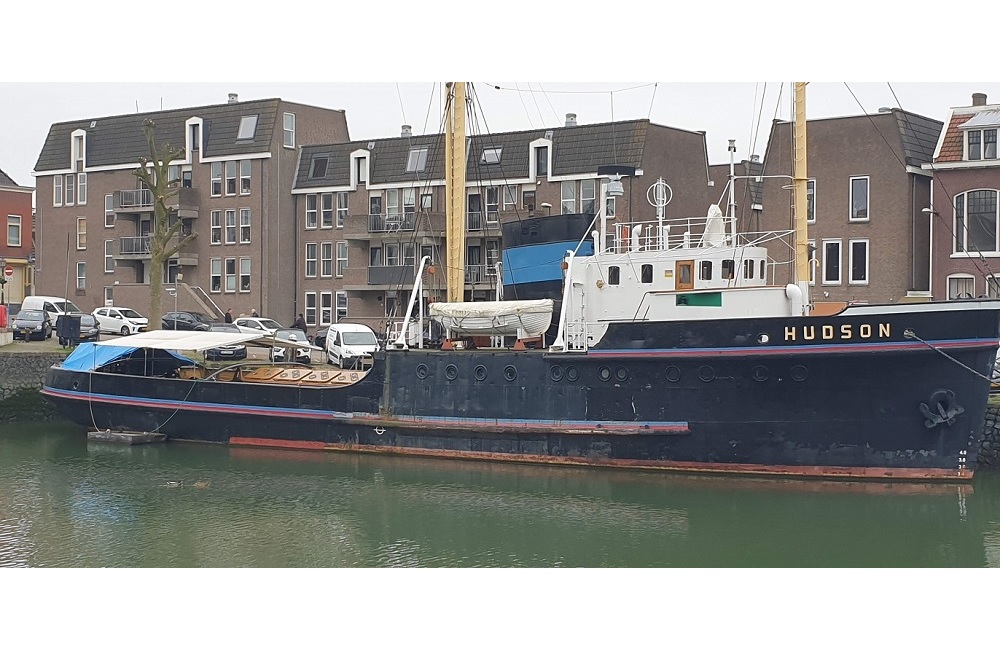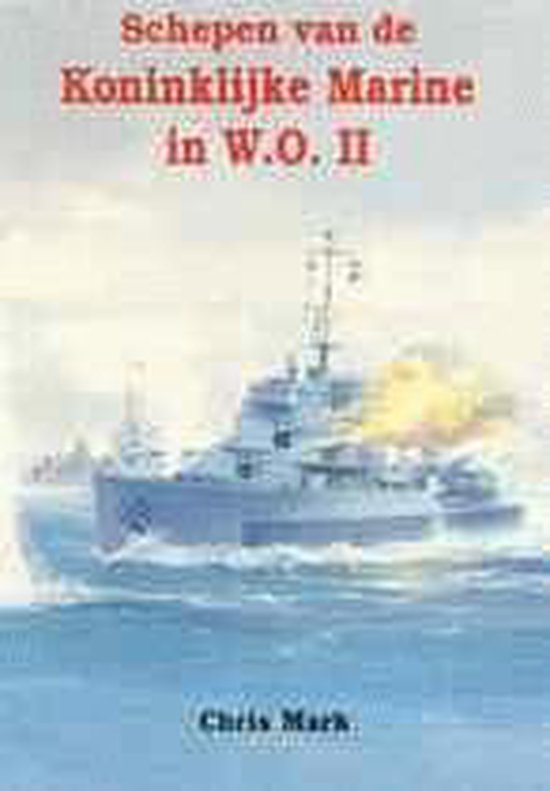Preface
Operation Neptune was the maritime counterpart of Operation Overlord, the allied landing in Normandy that started at 6 June 1944, the day that is better known as D-Day. All maritime operations in Normandy from 6 June until 90 days later were designated with the name Operation Neptune. These operations included the transport of troops and vehicles, the escorting of landing craft, the distraction of the German navy and air force and the further supply over seas. The construction of two temporary artificial harbours with code name Mulberry and the five breakwaters designated by the name Gooseberry also ressorted under Operation Neptune.
For Operation Neptune, the largest fleet of all times was gathered on the south coast of England. The armada consisted of, among other, no less than 1,213 warships varying from battleships to midget submarines. Over three quarters of these were either British or British/Canadian. 16,5 per cent was of American origin and 4,5 per cent was supplied by the navies from other allied countries like France, Poland, Norway, Greece and The Netherlands. The rest of the fleet that was destined to carry out Operation Neptune consisted of 4,126 merchant ships. This was a motley collection of adapted and specially designed ships, landing craft and troop transporters. There were many large and small passenger ships that had been converted to Landing Ship Tank (LST), Landing Ship Infantry (LSI), or Landing Ship Material (LSM). Many of these ships had landing craft on board that were designated as Landing Craft Assault (LCA), Landing Craft Tank (LCT) and Landing Craft Support (LCS). Besides, there were adapted ships for laying smoke screens or buoys, rescue vessels, hospital ships, tugs and even floating docks. Over three quarters of these ships sailed under the British flag, but the largest part was built in the United States and was transferred to the British on the basis of the Lend Lease Act.
This enormous fleet of 5,339 schips was on Sunday 4 June 1944 in position in the Channel when word was received that the invasion had been postponed from 5 June to 6 June. A part of the fleet cruised back and forth along the English south coast. Because of the bad weather circumstances the Germans held their reconnaissance planes grounded so that this unusual large concentration of ships remained unseen. This was essential for the whole plan of attack of the allies. The chance of success depended for a large part on the element of surprise. In the evening of 5 June 1944 the order "carry out Operation Neptune" was given by the British Admiral Bertram Ramsay, commander in chief of Neptune. The assembled fleet set itself in motion, from the Isle of Wight, in ten columns through ten small routes that had been cleared of mines. The routes were marked by buoys that had been laid at distances of five miles.
The Dutch contribution to Operation Neptune consisted of four warships, two tankers, twelve freighters and transporters, twelve tugs, eight fishing trawlers and tens of coastal vessels. On 1 July 1940 in Londen, the Netherlands Shipping & Trading Committee (NSTC) was established. This commission superintended the so called Vaarplichtwet, a law that obliged Dutch sailors to continue sailing on board of their own ship or on another allied ship. The NSTC was soon known by every Dutch sailor as the Shipping. Dutch vessels that managed to evacuate to England were registered with the NSTC. In this way they could be deployed in war tasks like Operation Dynamo, the evacuating of British and French troops from Dunkirk. Most of the Dutch ships that took part in Operation Neptune were deployed by the British Ministry of War Transport by entering into a special Liberator Charter. With this charter, the Dutch government took over all obligations to the crews of the ships in question. Like all charter contracts, the Liberator Charter was a so called timecharter, a renting period for a certain time.
Definitielijst
- D-Day
- The day of the long awaited invasion of western Europe in Normandy, France, 6 June 1944. After a long campaign of deception the allies attacked the coast of Normandy on five beaches to begin their march on Nazi Germany. Often explained as Decision Day, though this is entirely correct. The D stands for Day as generally used in military language. In this case it means an operation beginning on day D at hour H. Hence “Jour J“ in French.
- Infantry
- Foot soldiers of a given army.
- invasion
- Armed incursion.
Images
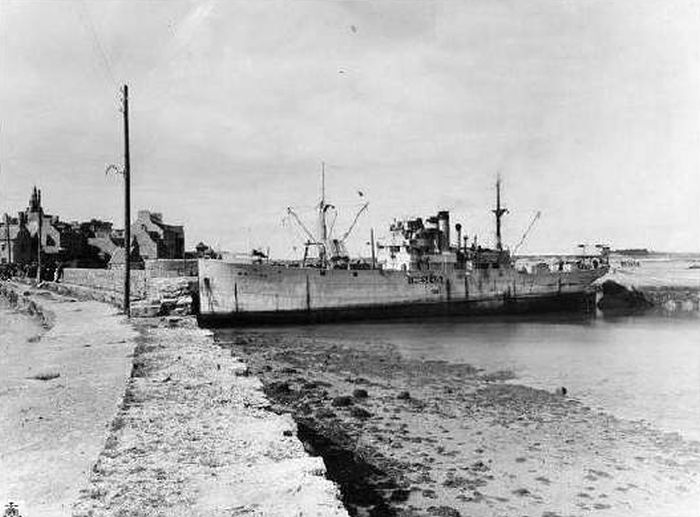 The Dutch steam ship Theseus in a harbour in Normandy during Operation Neptune. Source: P. Kimenai G02War2.
The Dutch steam ship Theseus in a harbour in Normandy during Operation Neptune. Source: P. Kimenai G02War2.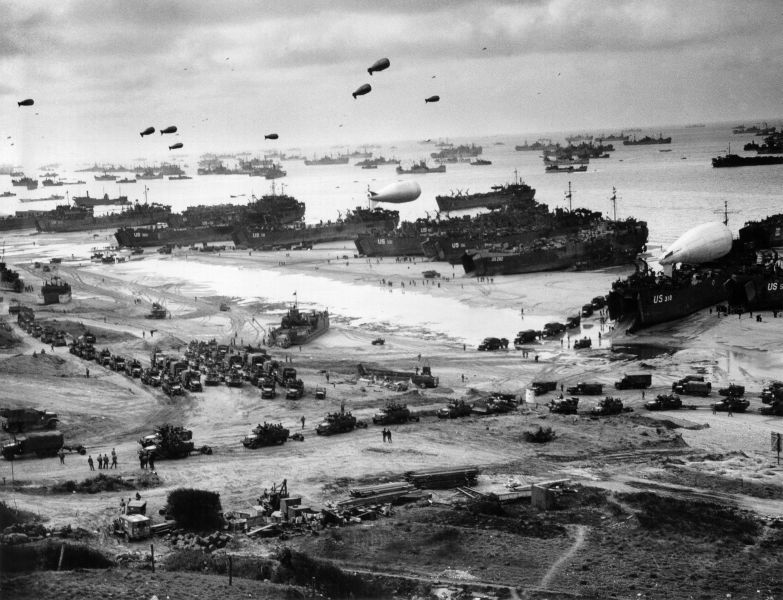 Supplying the Normandy Beaches a couple of days after D-Day. Source: Wikipedia.
Supplying the Normandy Beaches a couple of days after D-Day. Source: Wikipedia.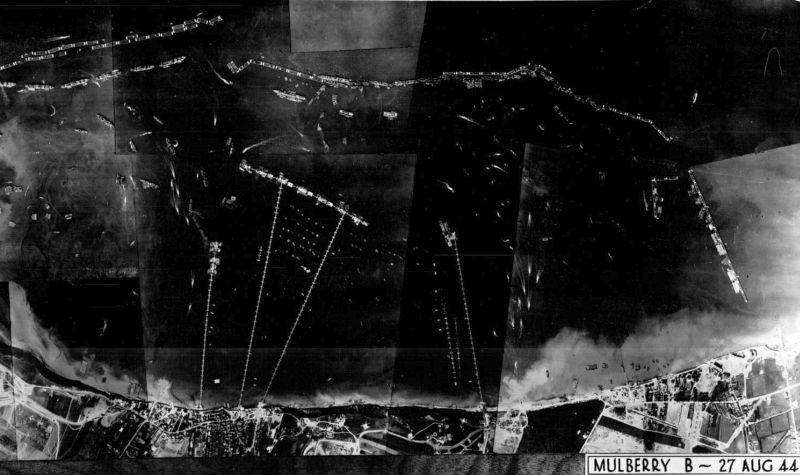 Mulberry B and Gooseberries 3, 4 and 5 on 27 August 1944. Source: Ukho.
Mulberry B and Gooseberries 3, 4 and 5 on 27 August 1944. Source: Ukho.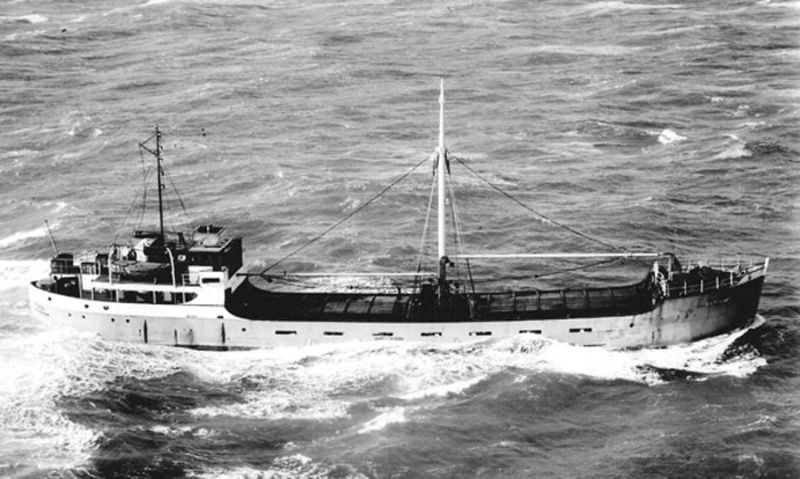 Th Dutch coaster Ton-S was involved in Operation Neptune. Source: Shipspotters.
Th Dutch coaster Ton-S was involved in Operation Neptune. Source: Shipspotters.Four war ships
The British and American Supreme Commanders of Operation Neptune and Operation Overlord were convinced of the fact that it would be a morale raiser for the smaller allies when they could contribute to the liberation of western Europe. For that reason, it was decided to add several Norwegian, Polish, Dutch and Greek warships to Operation Neptune. For the same reason, among others Belgian commando's, Danish marines, the Dutch Prinses Irene Brigade and Greek and Czech soldiers were deployed during Operation Overlord. The contribution of the Free French ships and troops was a matter of course with the invasion of Normandy.
The Dutch gunboats of the Flores-class, Hr. Ms. Flores and Hr. Ms. Soemba, were selected to reinforce the allied coastal bombardment fleet. Both ships had earned a decent reputation by their earlier actions in the Mediterranean. They were known as "The Terrible Twins". The Flores was assigned to the British sector and was tasked with shelling the German positions at Gold Beach. Hr. Ms. Soemba was assigned to the American sector and was ordered to do the same thing at Utah Beach. Both gunboats remained at their posts after D-Day in order to support further operations. The 15cm guns of both ships were worn out several times so that the boats had to return to Portsmouth in order to change guns with the laid up Dutch cruiser Hr. Ms. Sumatra.
Hr. Ms. Sumatra was used during Operation Neptune as a blocking ship in Gooseberry 5. The cruiser was laid up because of overdue repairs and lack of crew members. At the request of the British Admiralty, the ship was made available as a sinking ship. On 9 June 1944 the old cruiser was sunk by means of explosive charges at approximately 4,500 meters from the coast off Ouistreham in water with a depth of 7.5 meters. In 1951 the wreck was hoisted and sold for scrap.
The minelayer Hr. Ms. Douwe Aukes could escape to Great Brittain in May 1940 and was assigned, from 12 June of that year, to the Thames Local Defence Flotilla. On 29 April 1941, the ship was handed over to the Royal Navy because the Dutch crew were needed to equip the new Dutch minesweepers. The British then equipped the ship with anti aircraft guns and under name sign T 309 the old minelayer served as an anti aircraft gunboat. In that role the Douwe Aukes, on 7 June 1944, was moored in Port-en-Bessin to shoot at German aircraft. After the war the minelayer returned to Dutch service as a depot ship for minesweepers and as an accommodation ship.
Definitielijst
- Brigade
- Consisted mostly of two or more regiments. Could operate independently or as part of a division. Sometimes they were part of a corps instead of a division. In theory a brigade consisted of 5,000 to 7,000 men.
- cruiser
- A fast warship with 8,000 – 15,000 ton displacement, capable to perform multiple tasks such as reconnaissance, anti-aircraft defence and convoy protection.
- D-Day
- The day of the long awaited invasion of western Europe in Normandy, France, 6 June 1944. After a long campaign of deception the allies attacked the coast of Normandy on five beaches to begin their march on Nazi Germany. Often explained as Decision Day, though this is entirely correct. The D stands for Day as generally used in military language. In this case it means an operation beginning on day D at hour H. Hence “Jour J“ in French.
- invasion
- Armed incursion.
- shelling
- Indication for shooting targets with grenades. Both from artillery and armoured artillery.
Images
 The sloop Hr. Ms. Flores probebly was, together with her sister ship Hr. Ms. Soemba, the most important Dutch contribution to Operation Neptune. Source: Kombuispraat.
The sloop Hr. Ms. Flores probebly was, together with her sister ship Hr. Ms. Soemba, the most important Dutch contribution to Operation Neptune. Source: Kombuispraat.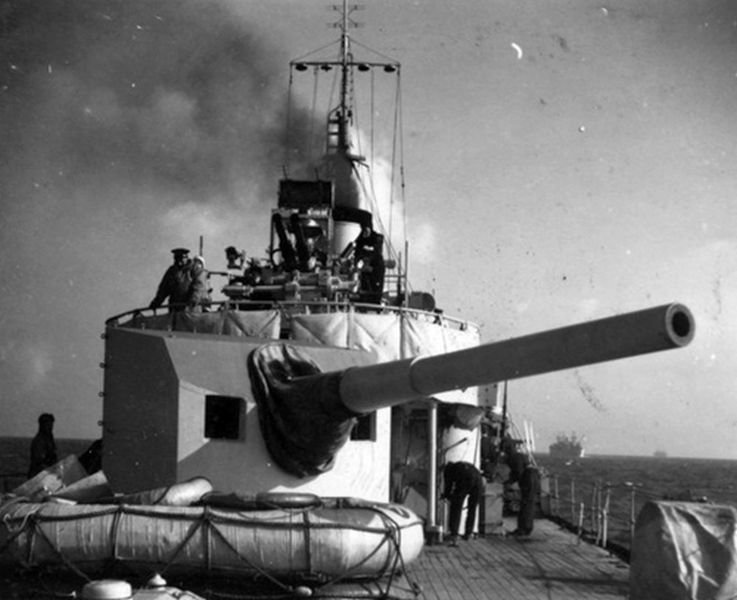 Hr. Ms. Soemba in action on D-Day. Source: Marineschepen.
Hr. Ms. Soemba in action on D-Day. Source: Marineschepen. The Dutch cruiser Hr. Ms. Sumatra is part of the Gooseberry near Ouistreham. Source: www.en.wikipedia.org.
The Dutch cruiser Hr. Ms. Sumatra is part of the Gooseberry near Ouistreham. Source: www.en.wikipedia.org.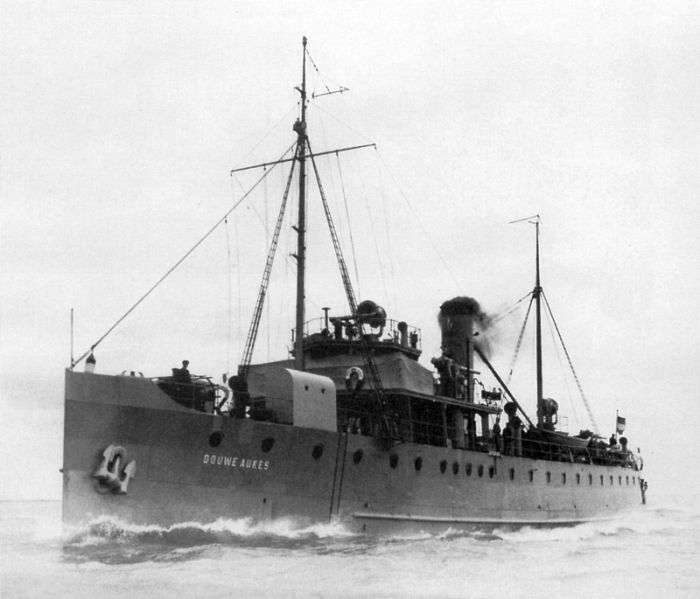 The Dutch minelayer Hr. Ms. Douwe Aukes was in British service as anti aircraft gunboat during Neptune. Source: Wikipedia.
The Dutch minelayer Hr. Ms. Douwe Aukes was in British service as anti aircraft gunboat during Neptune. Source: Wikipedia.Twelve freighters, two tankers
The Dutch contribution to Operation Neptune considering merchantmen, besides the tugs and the coasters, consisted of two tankers, two channel boats converted to landing ships, two sinking ships, an adapted passenger ship and some seven freighters.
The ss Parklaan from shipping company N.V. Stoomschip Hannah in Rotterdam had been out of service for some time and had been laid up in Methil, southeast Scotland. Captain A. van Hilten from the Shipping demanded the 3,807 ton ship from 1911 for Operation Neptune on 21 April 1944. A British crew prepared the ship by depositing 3,000 tons of sand as ballast into the ship, drilling holes in the watertight bulkheads and removing the winches, the derricks, the reserve anchor, the reserve screw and the gun. On 25 April, a Dutch crew took over the ship. In the holds, explosive charges were put and coals were loaded. On 23 May, the Parklaan left with a number of other blockade ships to Oban on the Scottish west coast, where all blockade ships for Operation Neptune gathered. On board of Hr. Ms. Sumatra, a meeting was held for all captains of the blockade ships. On D-Day the sinking ships left in convoy towards Normandy and the next day they arrived in the bay of the Seine. On 8 June, the ss Parklaan was sunk as the fourth ship of Gooseberry 3 in front of Gold Beach.
The ss Parkhaven from the Van Udens Scheepvaart en Agentuur Mij. in Rotterdam was also claimed as a blockade ship. The 4,803 ton steam ship from 1920 under Captain J. Holstein however only left for Normandy in the beginning of July. The ship had to fill a hole of 90 meters in Gooseberry 3. On 10 July, 1944 the ship was sunk by explosives on the right spot after that it had been fastened with cables to the wrecks that lay before and behind.
The ss Vliestroom from 1912 of 655 ton, from the Hollandsche Stoomboot Maatschappij (HSM) in Amsterdam, made her first voyage from South England to Normandy under captain H.G. Colenbrander on 8 June 1944. On board was a cargo of 800 tons of ammunition and 44 American boat workers to unload these. The Dutch ship dropped its anchor under dangerous circumstances at Isigny-sur-Mer, in the far extreme southeastern corner of Omaha Beach. Because of an indirect bomb hit the ship was damaged before its cargo had been unloaded. Only two days later the Vliestroom could steam to the right unloading position and be unloaded by the Americans using small landing craft. After this the Dutch ship departed in convoy to England. The voyage to and from had cost a week. The Vliestroom consequently made another eightteen voyages to Normandy in order to deliver ammunition. Also the new motor ship Starkenborgh from 1941 of the HSM took part in Operation Neptune as a supply ship.
The three steam ships of the Koninklijke Nederlandse Stoomboot Maatschappij (KNSM), the Euterpe from 1903 of 1,165 ton, the Theseus from 1920 of 1,690 ton and the Vulcanus from 1907 of 1,819 ton, like the Vliestroom, sailed several times from South England to Normandy to supply the allies. They transported less dangerous materials like material for the engineers, telephone equipment and food. The ss Zuiderburgh from Wm. H. Müller & Co. in Rotterdam was the former Maashaven of 2,630 ton from 1907. The shipping company from Rotterdam had taken over the ship in 1940 from the Gebr. van Uden and rechristened the ship to Zuiderburgh. The old ship only sailed at seven knots but nevertheless deposited countless freights for the allies in Normandy. This started with delivering ammunition, fuel and food stuffs at Utah Beach soon after D-Day until the supplying of liberated harbours like Le Havre, Dieppe, Boulogne, Calais and Ghent until August 1945.
The steamship Batavier II, which had served as Hr. Ms. Batavier II as an accommodation ship for the Dutch Royal Navy in Falmouth, served during Operation Neptune as Hospital Carrier. The transport ship of wounded made a total of 35 voyages from Cherbourg to Southampton and transported a total of 7,086 wounded and sick allied troops.
Both the newly built channel boats ss Mecklenburg and ms Koningin Emma were directly involved as Landing Ships on D-Day. The Mecklenburg under Captain L.M. Meijer, that had served as an accommodation ship for the Royal Dutch Navy as Hr. Ms. Mecklenburg, put troops ashore as LSI 344 on Juno Beach. The Koningin Emma, as HMS Queen Emma in British service under Captain T.L. Alkin, landed 372 troops on Juno Beach. Both ships would bring more military to Normandy in the coming weeks.
The two tankers of the Curaçaose Scheepvaart Maatschappij in Willemstad, the Juliana from 1928 and the Lucita from 1926 were sisterships with a displacement of 3,040 ton. The ships constituted a link for some time between South England and Juno Beach for the supply of fuel. The only Liberty Ship that sailed under Dutch flag, which was exploited by the Holland Amerika Lijn (HAL) and which received the name Fort Orange, was deployed during Operation Neptune for the transport of military material.
In some sources the Dutch merchantmen Katwijk, Kelbergen and Wilhelmina are mentioned as ships that were active during Operation Neptune, but no details of this nor even confirmation can be found.
Definitielijst
- D-Day
- The day of the long awaited invasion of western Europe in Normandy, France, 6 June 1944. After a long campaign of deception the allies attacked the coast of Normandy on five beaches to begin their march on Nazi Germany. Often explained as Decision Day, though this is entirely correct. The D stands for Day as generally used in military language. In this case it means an operation beginning on day D at hour H. Hence “Jour J“ in French.
Images
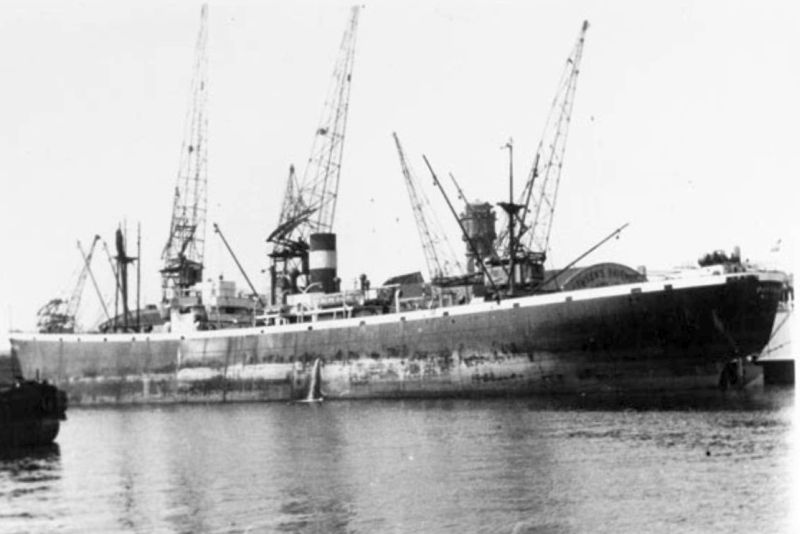 The Parkhaven in Rotterdam before the war. The ship was scuttled as part of Gooseberry 3. Source: Maritiem Digitaal.
The Parkhaven in Rotterdam before the war. The ship was scuttled as part of Gooseberry 3. Source: Maritiem Digitaal.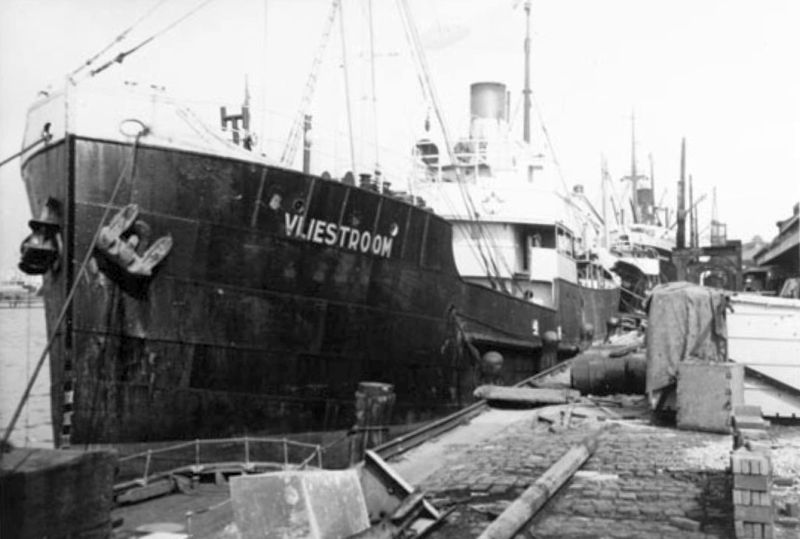 The ss Vliestroom made 19 very dangerous voyages as an ammunition ship from England to Normandy. Source: Maritiem Digitaal.
The ss Vliestroom made 19 very dangerous voyages as an ammunition ship from England to Normandy. Source: Maritiem Digitaal.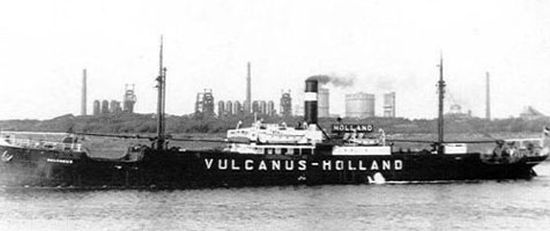 The old steamship Vulcanus brought war supplies to Normandy during Operation Neptune. Source: Kombuispraat.
The old steamship Vulcanus brought war supplies to Normandy during Operation Neptune. Source: Kombuispraat.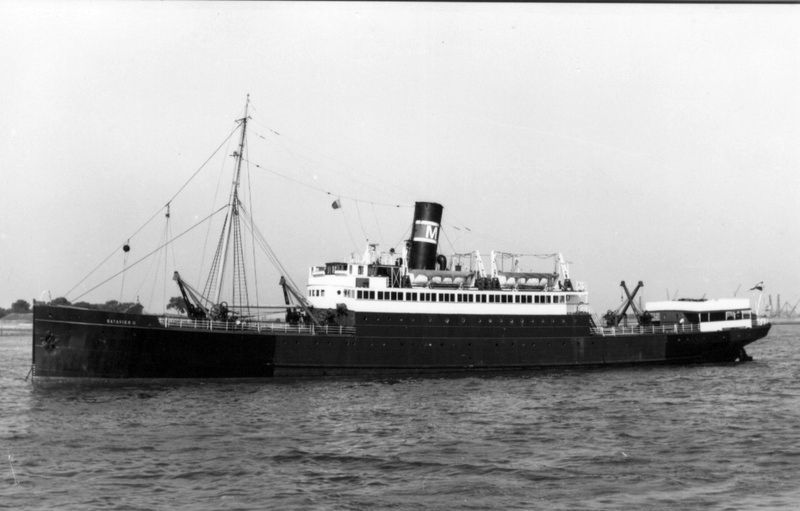 The Batavier II in 1921. Source: Kustvaartforum.
The Batavier II in 1921. Source: Kustvaartforum.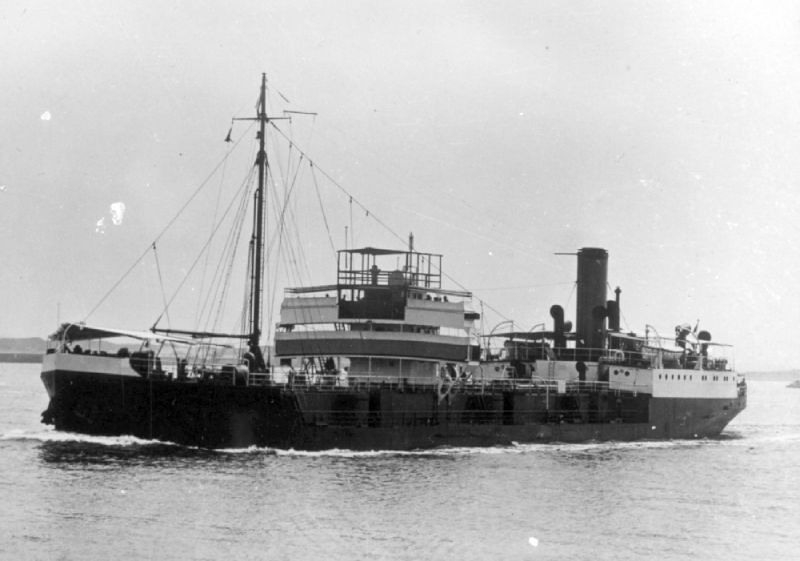 The tanker Juliana owned by the Curaçaose Scheepvaart Maatschappij. Source: Helder Line.
The tanker Juliana owned by the Curaçaose Scheepvaart Maatschappij. Source: Helder Line.Twelve tugs
In order to transport the parts of the Mulberry harbours, like Phoenix caissons, to the coast of Normandy no less than 300 tugs were needed. Most of them were British or American, but there were 12 tugs from Dutch origin or with Dutch crews on board. The twelve Dutch tugs that were assigned to Operation Neptune were:
| Ship | Owner | Construction year | Displacement | Fate |
| ss Amsterdam | Bureau Wijsmuller | 1938 | 368 ton | December 1960 sold for scrap to Nieuw Lekkerkerk |
| ss Antic | British Admiralty | 1943 | 700 ton | Scrapped in 1969 in Blyth, Engeland |
| ss Dexterous | British Admiralty | 1942 | 700 ton | Srapped in 1969 in Perama, Greece |
| ss Donau | L. Smit & Co. | 1910 | 239 ton | Scrapped in 1946 in Hendrik-Ido-Ambacht |
| ss Ebro | L. Smit & Co. | 1931 | 268 ton | Ran aground on 11 January 1958 near Westkapelle and was lost |
| ss Goliath | S.A. de Remorquage á Helice | 1925 | 354 ton | Unknown |
| ms Hudson | L. Smit & Co. | 1939 | 294 ton | Museumship in Maassluis |
| ms Roode Zee | L. Smit & Co. | 1938 | 468 ton | Torpedoed on 24 April 1944 By German MTB S100 |
| ss Seine | L. Smit & Co. | 1908 | 308 ton | Sold for scrap in January 1946 to Hendrik-Ido-Ambacht |
| ss Schelde | L. Smit & Co. | 1926 | 360 ton | Sold for scrap in October 1954 to Hendrik-Ido Ambacht |
| ms Thames | L. Smit & Co. | 1938 | 18 april 1940 | Ran into a reef in November 1964 in the Phillipines |
| ms Zwarte Zee | L. Smit & Co. | 1933 | 793 ton | Sold for scrap in October 1966 to Hendrik Ido-Ambacht |
The steam tugs Amsterdam, Ebro and Schelde were requisitioned on 24 Augustus 1939 by the Royal Dutch Navy and were put into service as surveillance vessels Hr. Ms. BV 3, Hr. Ms. BV 38 and Hr. Ms. BV 37.
The Antic and the Dexterous were British tugs of the Assurance-klasse, but had been brought under Dutch flag by the British Admiralty and sailed with a Dutch crew from L. Smit & Co. The Goliath from S.A. de Remorquage a Helice in Antwerp had escaped in May 1940 from Zeebrugge, but its crew lacked any towing experience. The British Admiralty therefore placed Captain B.C. Weltevrede and the crew of the lost Witte Zee (Hr. Ms. BV 5) on this ship.
The motor seatug Zwarte Zee was, at 3,300 hp, the strongest tug in the world. During Operation Neptune the tug towed, besides Phoenix caissons, the British monitor HMS Erebus of over 7,000 ton. This was not a problem for the tug, but towing the British battleship HMS Warspite of over 33,000 ton to Le Havre, cost the Zwarte Zee more trouble. The Dutch tug managed to cope, however, under all circumstances.
The new seatug Roode Zee from L. Smit & Co. was already assigned to Operation Neptune in March 1944. The tug was torpedoed on 24 April 1944 near Dungeness by the German motor torpedo boat S 100. The bunkerroom was hit and after a giant flash the tug exploded after which nothing was found of the vessel. All 15 crew of the Roode Zee perished in this disaster. The S 100 was a Schnellboot that was built on the shipyard of Fr. Lürsen in Vegesack and was commissioned on 5 May 1943. The boat belonged to the 5th flottilla Schnellboote and was destroyed on 15 June 1944 in Le Havre together with six other German motor torpedo boats by an allied air attack.
Definitielijst
- battleship
- Heavily armoured warship with very heavy artillery.
- torpedo
- A weapon of war. A cigar shaped body fitted with explosives and a propulsion and control mechanism. Intended to target after launch a nearby enemy ship and disable it by underwater explosion.
Images
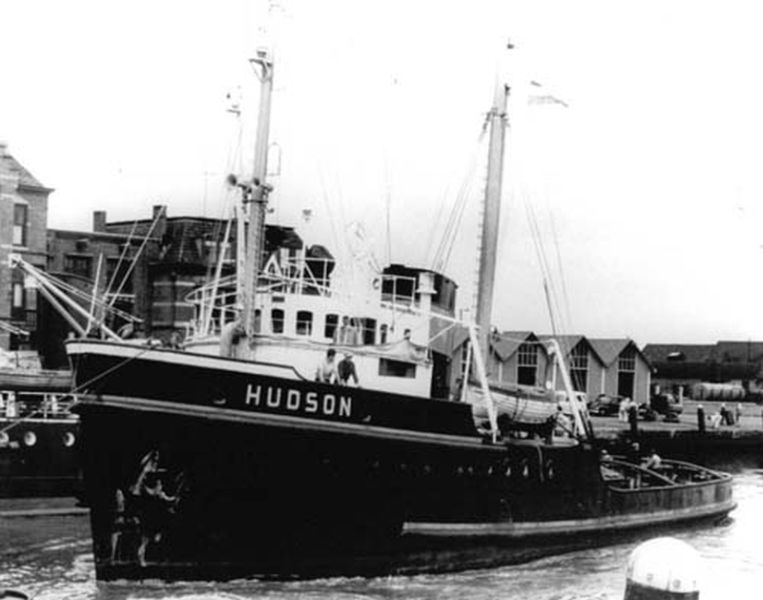 The motortug Hudson can be visited as a museumship in Maassluis. Source: Museumschip Hudson.
The motortug Hudson can be visited as a museumship in Maassluis. Source: Museumschip Hudson.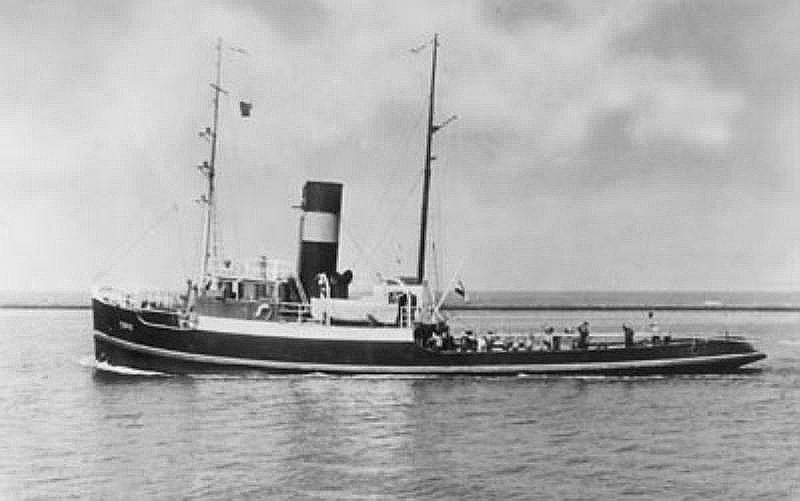 The tug Ebro served the Royal Dutch Navy as BV 38 from August 1939 to May 1940. Source: Shipspotters.
The tug Ebro served the Royal Dutch Navy as BV 38 from August 1939 to May 1940. Source: Shipspotters.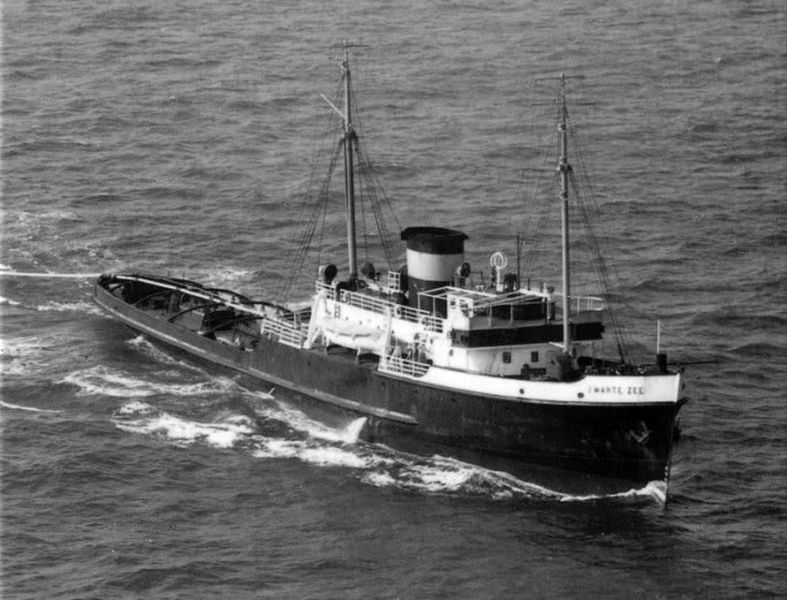 The Zwarte Zee was the most powerful tug of the world and was very important during Operation Neptune. Source: Kombuispraat.
The Zwarte Zee was the most powerful tug of the world and was very important during Operation Neptune. Source: Kombuispraat.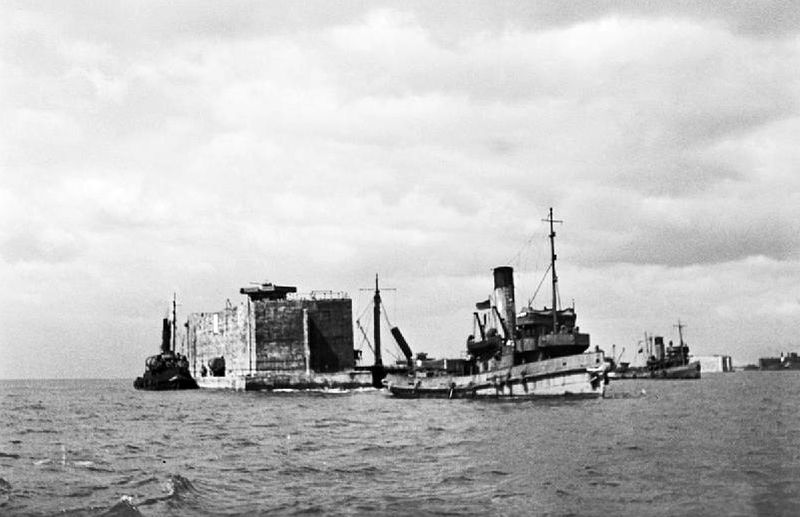 A Phoenix Caisson in tow during Operation Neptune. Source: Ukho.
A Phoenix Caisson in tow during Operation Neptune. Source: Ukho.Eight trawlers
The British Admiralty had assigned some thirty trawlers, that had formerly served as auxiliary mine sweepers, to function as "smoke screen trawlers". These ships were destined to protect the Mulberry harbours and the Gooseberries from air attacks by laying smoke screens. Of these thirty trawlers, six had Dutch origins. These were the Bruinvisch, Goeree, Isabel, Jaqueline Clasine, Libra and Maria Elizabeth. These fishing boats had been in service during the beginning of the war as Dutch auxiliary mine sweepers Hr. Ms. Bruinvisch, Hr. Ms. Goeree (former Hr. Ms. Dolfijn), Hr. Ms. Isabel, Hr. Ms. Jaqueline Clasine, Hr. Ms. Libra and Hr. Ms. Maria Elizabeth. The ships were later handed over to the Royal Navy when the trawlers were replaced by the motor mine sweepers of the Ameland class and the motor mine sweepers of the Duiveland class.
Another former Dutch auxiliary mine sweeper, the En Avant, towed the British midget submarine HMS X 23, that had served as a navigational beacon for Juno Beach, back to Portsmouth. The En Avant had served as the auxiliary mine sweeper Hr. Ms. En Avant with the Royal Dutch Navy from June 1940 until May 1943. From 26 September 1939 on, the fishing boat had been in Dutch service as surveillance ship Hr. Ms. BV 42.
The eighth Dutch trawler that was involved in Operation Neptune was the Uiver. The ship had been assigned to the American sector as a net barrier layer. The task of the Uiver was to lay net barriers against German U-boats and torpedoes. The Uiver had served as auxiliary mine sweeper Hr. Ms. Uiver from 17 October 1940 until 23 November 1942.
Definitielijst
- mine
- An object filled with explosives, equipped with detonator which is activated by either remote control or by colliding with the targeted object. Mines are intended to destroy of damage vehicles, aircrafts or vessels, or to injure, kill or otherwise putting staff out of action. It is also possible to deny enemy access of a specific area by laying mines.
Images
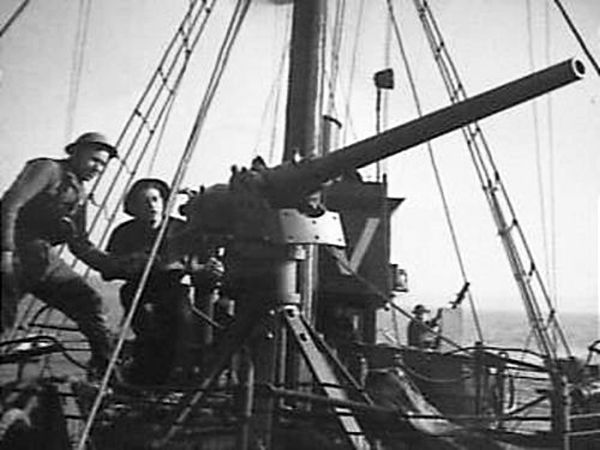 A British gunnery crew on board the Isabel during Operation Neptune. Source: Ukho.
A British gunnery crew on board the Isabel during Operation Neptune. Source: Ukho.Coasters
The Dutch coasters were part of the fleet of allied coasters that numbered hundreds of boats. The ships had several assignments but were mostly deployed as transport ships. Despite their limited capacity, the coasters were the ideal ships for this task. Thanks to their shallow draft they could moor in recently captured small harbours like Ouistreham, Courseulles-sur-Mer and Port-en-Bessin. Some captains even received the order to beach their ship at high tide so that the ship could be unloaded directly at low tide. A number of Dutch coasters only made the trip from South England to Normandy once or a few times, but others were part of convoys that transferred allied material tens of times. A small number of Dutch coasters, like the Barendsz, Noord-Stad, Urmajo and Hondsrug, only served as pumping boats for emptying the Phoenix caissons of the Mulberry harbours.
Following is a summary of all Dutch coasters that were involved in Operation Neptune. Some you won't find in Dutch summaries because they were built under another name. Others you won't see in the lists because they were chartered not on the basis of a timecharter but directly from Dutch shipowners. Some coasters are never mentioned because they were active for Operation Neptune months after D-Day, but as was mentioned before, this maritime operation lasted until 90 days after D-Day. When in the summary under End of Timecharter nothing is mentioned, it can mean that this date is unknown or that the ship was not hired under a timecharter.
| Ship | Constructed | Displacement | End of timecharter | Fate |
| Actinia | 1938 | 445 ton | 15 July 1945 | Scrapped in Dortmund, Germany, 1974 |
| Agiena | 1936/1937 | 415 ton | 1 June 1945 | Sunk in 1958 in English waters after a collision |
| Alcyone | 1938 | 420 ton | June 1945 | Unknown, not mentioned in Lloyds Register after 1999 |
| Amazone | 1939 | 320 ton | 29 June 1945 | Sunk after a collision in the Channel, 1963 |
| Antilope | 1939 | 270 ton | 1 June 1945 | Sold for scrap in 1971 to Hendrik-Ido-Ambacht |
| Att-S | 1937 | 650 ton | August 1945 | Sold for scrap in June 1980 |
| Barendsz | 1931 as Apollinarus VI | 365 ton | Sunk on 7 December 1963 after a collision | |
| Bellatrix | 1939 | 325 ton | 1 June 1945 | Scrapped in Nigeria, 1986 |
| Borneo | 1937 | 418 ton | In 1963 scrapped in Sufa, Fiji | |
| Brem | 1939 as Fram | 545 ton | 1 June 1945 | In 1974 scrapped in Gotenburg, Sweden |
| Coen | 1935 | 365 ton | 1 June 1945 | Scrapped in Krimpen a/d IJssel, February 1972 |
| Confid | 1930/1931 as Gier | 330 ton | Scrapped in Hamburg, Germany, 1972 | |
| Cresendo | 1938 | 435 ton | Juni 1945 | Scrapped in 1971 in Nieuw-Lekkerland |
| Da Costa | 1937 | 290 ton | June 1945 | Sunk on 21 November 1986 during a storm in te Caribbean Sea |
| Despatch | 1931 as Atlas | 255 ton | June 1945 | Removed from Lloyds Register in 1993 |
| Doggersbank | 1939 | 208 ton | 1 July 1945 | Sunk in 1972 during a storm in France |
| Drittura | 1929 | 230 ton | 1 June 1945 | Under the name Storebaelt the ship sails as a sailing passenger ship from Harlingen. |
| Duurswold | 1936 | 255 ton | Removed from Lloyds Register in 2010 | |
| Erna | 1940 | 430 ton | Ran aground on 30 June 1957 in South Africa and scrapped | |
| Evertsen | 1930 as Flying Scotsman | 545 ton | Ran aground on the Spanish northeast coast, 17 May 1971 | |
| Express | 1929 | 240 ton | Scrapped in Zierikzee, July 1981 | |
| Fiducia | 1939 | 320 ton | Scrapped in Nieuw Lekkerland, July 1973 | |
| Helvetia | 1939 | 310 ton | 1 June 1945 | End 1972 scrapped in Leer, Ireland |
| Heron | 1938 | 330 ton | June 1945 | June 1987 scrapped in Zeeland |
| Hondsrug | 1937 as Anbeja | 285 ton | June 1945 | Lloyds registration expired in 1995 |
| Houtman | 1931 as Flying Norseman | 545 ton | Sunk on 12 June 1964 near Honfleur after a collision with a wreck | |
| Inspecteur Mellema | 1939 | 320 ton | 1 June 1945 | Unknown |
| Jacoba | 1939 | |||
| Jan Brons | 1939 | 540 ton | Sunk on 12 October 1945 after a collision in the Channel | |
| Jola | 1935 | 330 ton | 1 June 1945 | March 1984 scrapped in Graasten, Denmark |
| June | 1938 as Ransel | 560 ton | 1 June 1945 | Sunk in the Gulf of Bothnia, 22 January 1965 |
| Mulan | 1931 | 300 ton | In 1963 scrapped in Port Glasgow, Scotland | |
| Nato | 1939 | 550 ton | 31 August 1945 | Scrapped in 1991 |
| Nettie | 1937 | 655 ton | In 1997 removed from Lloyds Register | |
| Nezo | 1939 | 270 ton | 1 June 1945 | Unknown |
| Njord | 1939 | 425 ton | Sunk on 7 November 1974 in the North Sea after heeling | |
| Noord-Stad | 1931 | 360 ton | 1 June 1945 | Sunk after beaching in Norwegian waters, 13 March 1980 |
| Omlandia | 1937 | 530 ton | 1 June 1945 | Scrapped in Ghent, Belgium, June 1973 |
| Oosterhaven | 1941 as Empire River | 342 ton | In 1998 removed from Lloyds Register | |
| Pacific | 1938 | 400 ton | Torpedoed in the bay of Falmouth by U-399, 26 March 1945 | |
| Patria | 1937 | 420 ton | June 1945 | Sold for scrap to Perama, Greece, January 1989 |
| Rose Marie | 1939 as Niagara | 510 ton | In 1980 scrapped in La Coruna, Spain | |
| Sambre | 1929/1930 | 558 ton | July 1945 | End 1970 scrapped in Krimpen a/d IJssel |
| Sparta | 1940 | 325 ton | 1 June 1945 | Sunk after beaching on Finnish islands, 17 October 1949 |
| Surte | 1939 | 310 ton | 1 June 1945 | Unknown |
| Tilly | 1939 | 445 ton | Scrapped in Scotland, June 1971 | |
| Ton-S | 1937 | 650 ton | Sold for scrap to La Spezia, Italy, August 1971 | |
| Triton | 1935 | 375 ton | 1 June 1945 | Unknown |
| Tromp | 1932 as Flying Dutchman | 545 ton | Sunk in Danish waters after a collission with a mine, 8 December 1946 | |
| Urmajo | 1937 | 405 ton | In 1998 removed by Lloyds from Register | |
| Van Brakel | 1929 as Zuid-Beijerland | 550 ton | In October 1965 sunk near Sicily after beaching | |
| Vida | 1935 | 375 ton | 19 November 1945 | Scrapped in Ferrol, Spain, June 1972 |
| Walenburgh | 1938 | 765 ton | Scrapped in Greece, 1985 | |
| Wegro | 1938 | 310 ton | 1 June 1945 | End 1972 scrapped in Milton Creek, England |
| Westerhaven | 1942 as Empire Reynard | 325 ton | Scapped in Hull, England, April 1974 | |
| Westland | 1931 | 636 ton | Sunk in the North Sea during a storm, 30 January 1953 | |
| Wilja | 1939 | 275 ton | June 1945 | Removed from Lloyds Register in 1997 |
| Zeeland | 1930 | 600 ton | Lost at Punta Imperatore near Naples, 25 May 1971 | |
| Zeemeeuw | 1927 | 270 ton | Scutteld near Borga in the Gulf of Finland, 22 September 1981 | |
| Zuiderhaven | 1941 as Empire Sound | 351 ton | Scutteld in 1986 | |
| Zuidland | 1931 | 636 ton | Scrapped in Vado Ligure, Italy, 1976 |
Definitielijst
- D-Day
- The day of the long awaited invasion of western Europe in Normandy, France, 6 June 1944. After a long campaign of deception the allies attacked the coast of Normandy on five beaches to begin their march on Nazi Germany. Often explained as Decision Day, though this is entirely correct. The D stands for Day as generally used in military language. In this case it means an operation beginning on day D at hour H. Hence “Jour J“ in French.
- mine
- An object filled with explosives, equipped with detonator which is activated by either remote control or by colliding with the targeted object. Mines are intended to destroy of damage vehicles, aircrafts or vessels, or to injure, kill or otherwise putting staff out of action. It is also possible to deny enemy access of a specific area by laying mines.
Images
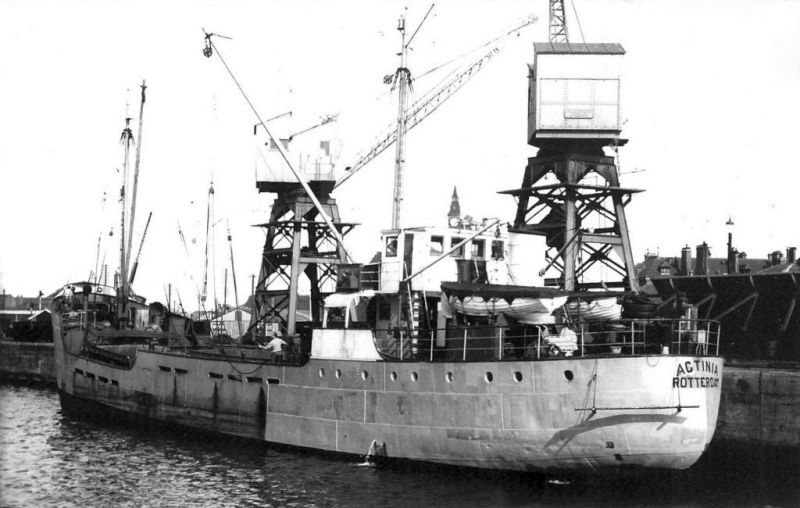 The coaster Actinia from Rotterdam in 1937. Source: Shipspotters.
The coaster Actinia from Rotterdam in 1937. Source: Shipspotters.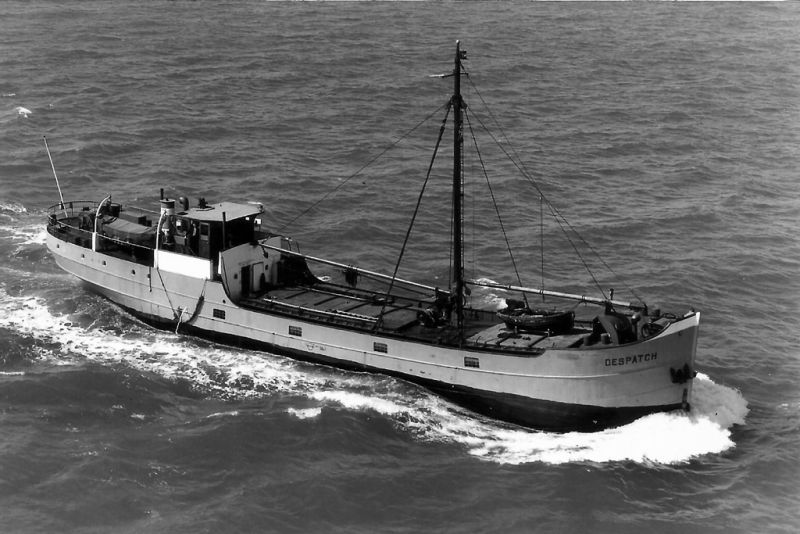 The Dutch coaster contributed to Operation Neptune as well. Source: Shipspotters.
The Dutch coaster contributed to Operation Neptune as well. Source: Shipspotters.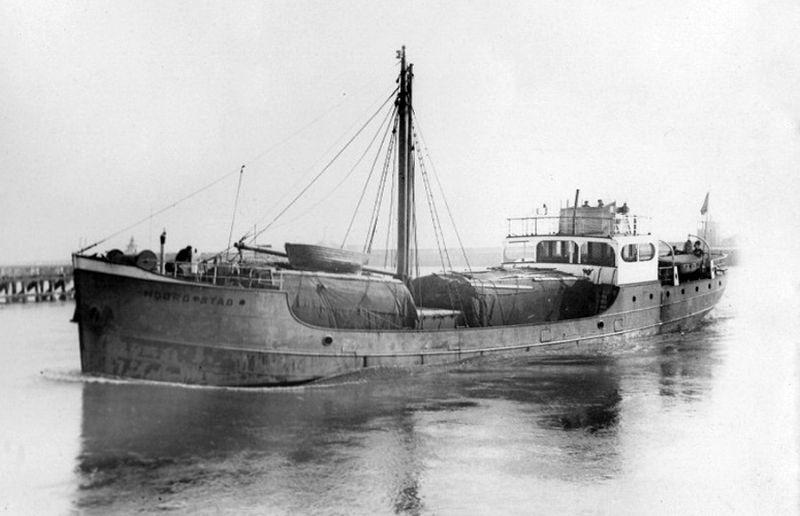 The Dutch coaster Noord-Stad served as pump boat to the purpose of the Phoenix Caissons. Source: Shipspotters.
The Dutch coaster Noord-Stad served as pump boat to the purpose of the Phoenix Caissons. Source: Shipspotters.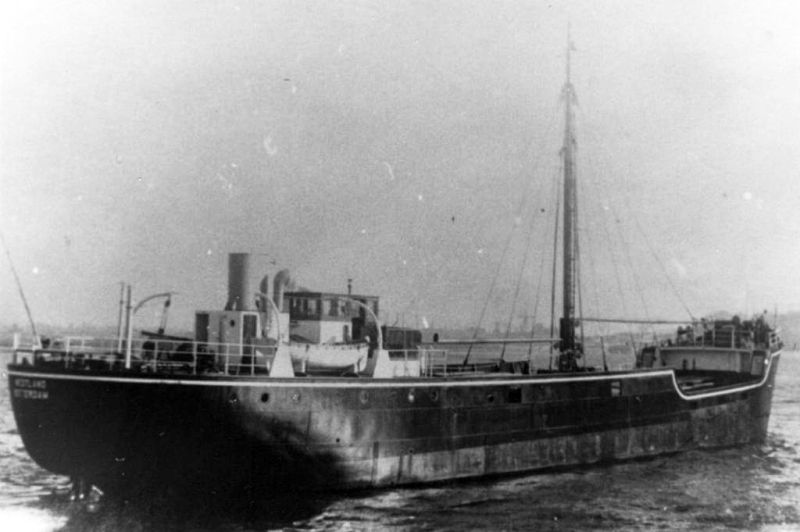 The coaster Westland was also deployed in the largest amphibious operation Europe had ever seen. Source: Shipspotters.
The coaster Westland was also deployed in the largest amphibious operation Europe had ever seen. Source: Shipspotters.Conclusion
The Dutch contribution to Operation Neptune was small but certainly not unimportant. The Dutch crew members of the warships, merchantmen, tankers and tugs were seasoned sailors and most of them, through the Vaarplichtwet, had experience with sailing in times of war. Especially thanks to the Dutch crews the Dutch ships were, although maybe slow and old, very much suited for an operation like Neptune.
Besides the before mentioned ships in this article a number of Dutch minesweepers were involved in clearing the south coast of England in preparation for the landings in Normandy. Hr. Ms. Marken (I) ran into an acoustic mine during this on 20 May 1944 and was lost. From seventeen crew members only one survived this disaster.
Definitielijst
- mine
- An object filled with explosives, equipped with detonator which is activated by either remote control or by colliding with the targeted object. Mines are intended to destroy of damage vehicles, aircrafts or vessels, or to injure, kill or otherwise putting staff out of action. It is also possible to deny enemy access of a specific area by laying mines.
Information
- Article by:
- Peter Kimenai
- Translated by:
- Peter ter Haar
- Published on:
- 15-07-2015
- Last edit on:
- 30-09-2024
- Feedback?
- Send it!
Related sights
Related books
Sources
- BAART, J.J., Rotterdam Oorlogshaven, Walburg Pers, Zutphen, 2010.
- BEZEMER, K.W.L., Geschiedenis van de Nederlandse Koopvaardij in de Tweede Wereldoorlog, Elsevier, Amsterdam, 1986.
- BEZEMER, K.W.L., Verdreven doch niet verslagen, Uitgeversmaatschappij W. de Haan N.V., Hilversum, 1967.
- BOSSCHER, PH., M., De Koninklijke Marine in de Tweede Wereldoorlog deel 2, Uitgeverij T. Wever B.V., Franeker, 1986.
- MARK, C., Schepen van de Koninklijke Marine in W.O. II, De Alk bv, Alkmaar, 1997.
- MüNCHING L.L. VON, De Nederlandse koopvaardijvloot in de Tweede Wereldoorlog, De Boer Maritiem, Bussum, 1978.
- MüNCHING, L.L. VON, Schepen van de Koninklijke Marine in de 2e wereldoorlog, De Alk bv, Alkmaar, 1978.
